How did Kafkaesque South Bohemia: International Literary Symposium unfold?

Šumava of Johannes Urzidil / Zvonková, October 5, 2024
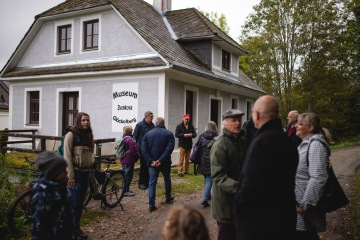
Despite the unfavorable weather forecast, over 35 participants from Germany, Austria, and the Czech Republic attended the "Urzidil’s Šumava" program. The attendees first visited the museum in Zvonková, which houses a memorial room dedicated to Johannes Urzidil. Afterward, at the restored cemetery, they listened to a deeply personal account of the post-1989 restoration of Zvonková from its main initiator, Horst Wondraschek from Linz. This story was accompanied by a projection of historical photographs of Zvonková, Josefův Důl, and Huťský Dvůr. Zdena Mrázková from the Seidel Photo Studio Museum in Český Krumlov and Lenka Hůlková from the Birthplace of Adalbert Stifter in Horní Planá also showcased many interesting postcards and photographs from old Šumava, bringing to life the period of Urzidil’s exile in Šumava following his dismissal from diplomatic service due to the rise of Nazism. On this occasion, Mr. Wondraschek was also presented with a gift in recognition of his long-standing work. The colorful mosaic of former daily life in the Zvonková area was further enriched by a tape recording of Urzidil’s memories of Franz Kafka.

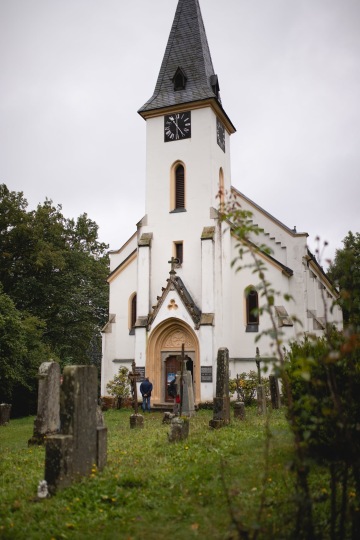


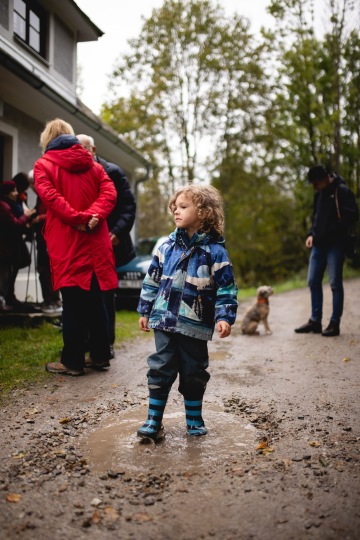
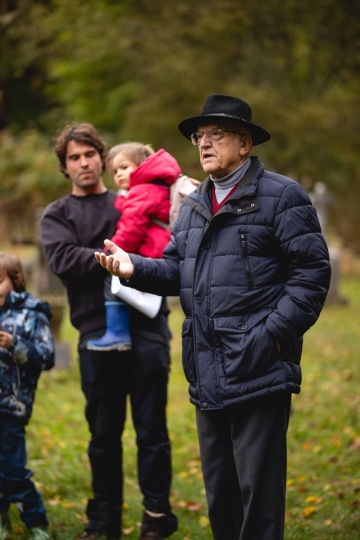
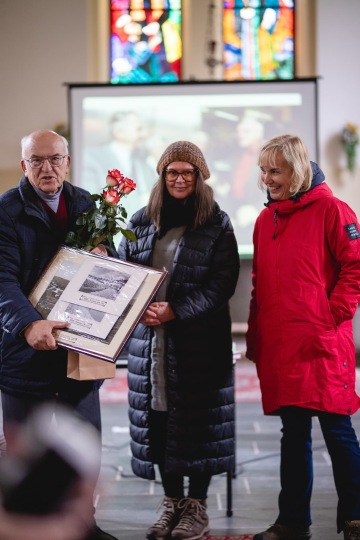

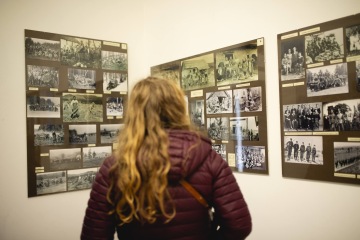
After the screening, the group set out on a guided excursion to Johannes Urzidil’s former summer residence, led by Miloš Minařík, chairman of the Johannes Urzidil Society. We continued to uncover many traces of the past, such as in the cellar of the former manor house or along the old garden fence of the remembered Prague German writer. Further details and context about Urzidil’s stays in Šumava were enriched by personal stories from Emma Marx, a native of nearby Huťský Dvůr.
This highly informative and symbolic gathering, held in a friendly atmosphere, included a coffee and cake break. The program concluded with an international picnic in Zvonková. Interest in the event exceeded expectations, especially given the poor weather forecast. Feedback was very positive, and the event garnered media attention. It also successfully fostered and strengthened cross-border cultural connections in the Czech-Austrian-German border region.
Kafkaesque South Bohemia: International Literary Symposium / Kende's villa, Č. Budějovice, October 12, 2024
By: Mikuláš Zvánovec, Luděk Němec
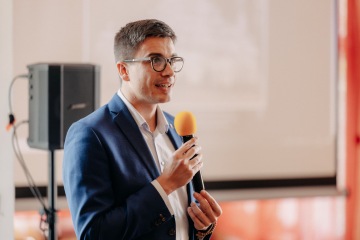
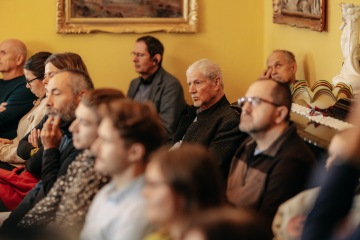
The culmination of the international project, which involved numerous domestic and foreign organizations such as the Adalbert Stifter Association in Munich, the Deutsches Kulturforum östliches Europa, the Šumava Litera literary festival, and the Seidel Photo Studio Museum, was the international literary symposium Kafkaesque South Bohemia, held at the Kende Villa in České Budějovice. The symposium’s program featured six expert presentations on the role of South Bohemia in the lives and works of writers associated with Franz Kafka’s literary circle.
A guided tour of the city of České Budějovice was organized for the presenters and international guests, focusing on the Czech-German-Jewish history of the city, as well as sharing future plans and projects related to the European Capital of Culture (ECOC) initiative. The tour included a visit to the Kende Villa, conducted in both German and Czech, where the remarkable architecture of the building was highlighted along with the often-overlooked history of the paralyzed composer Rudolf Kende and his family.
The venue for the symposium was chosen for its symbolic significance as a place where Czech, German, and Jewish histories intertwine in the region. The symposium was moderated by Franziska Mayer from the Adalbert Stifter Association in Munich and Mikuláš Zvánovec from the Borderland Center.
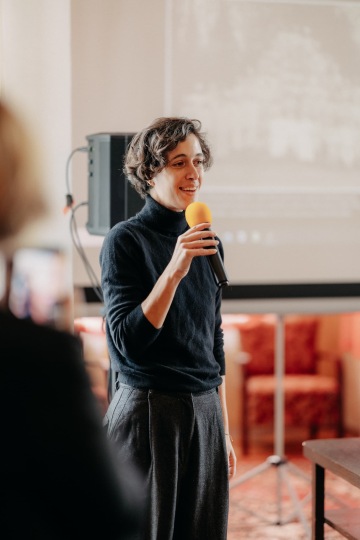
The symposium was opened by Anna Hořejší, the creative director of the European Capital of Culture (ECOC) project, followed by a welcome address from František Talíř, Deputy Governor of the South Bohemian Region. In the first lecture, Ivo Kareš, director of the South Bohemian Scientific Library, introduced the audience to the topic of German-speaking authors from Prague in the Šumava and South Bohemia regions. His talk was based on the electronic encyclopedia of German literature about Šumava called "Kohoutí kříž" (Cockerel Cross), which has been developing in České Budějovice for many years, with his significant involvement. The encyclopedia gathers information and works of authors who were forgotten or marginalized in the 20th century.
Writer Alena Wagnerová, known for biographies of Milena Jesenská and Sidonie Nádherná, gave a lecture on the family and South Bohemian roots of the world-renowned Franz Kafka. She vividly outlined the reflections of social issues in the lives of Franz Kafka and his father Hermann, who came from a poor rural Jewish family.
In the next presentation, Austrian historian and organizer of the cross-border cultural festivals Přechody/Übergänge, Thomas Samhaber, transported the audience to the time when Franz Kafka met his friend, Czech journalist Milena Jesenská, at the Czech-Austrian border, specifically at the train station in České Velenice. Kafka, however, also traveled to South Bohemia for other reasons, such as his summer vacation in Planá nad Lužnicí in 1922. Although he struggled to find peace due to the pervasive noise, the location may have inspired him to work on his seminal novel "The Castle," as Daniel Musílek from the University of South Bohemia in České Budějovice insightfully explained, drawing from Kafka’s correspondence.
The second part of the symposium was dedicated to Johannes Urzidil. Vera Schneider from the Deutsches Kulturforum östliches Europa in Potsdam delivered a lecture, supported by radio recordings, portraying Urzidil as both a writer and art historian who wrote in German but thrived in the vibrant intellectual and artistic world of Prague’s cafés, where language was not a dividing factor. This was seamlessly followed by a lecture from Miloš Minařík of the Johannes Urzidil Society, who, in addition to discussing Urzidil’s stays in Josefův Důl, provided insights into his connections with Czech painters.
Throughout the symposium, its international focus was maintained with a bilingual format, and all lectures were simultaneously interpreted (Czech-German). The event also proved to be highly productive in fostering cross-border networking among cultural actors within the Borderland Center project, contributing to its further development. Feedback was overwhelmingly positive. The symposium was praised for its unique combination of high-quality presentations, flawless organization, and the exceptional atmosphere of the chosen venue.

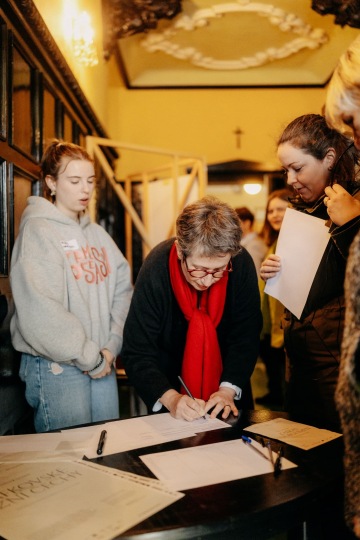
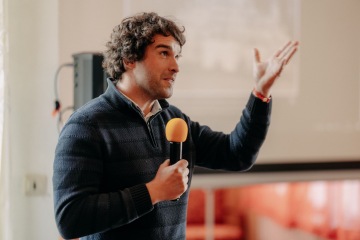
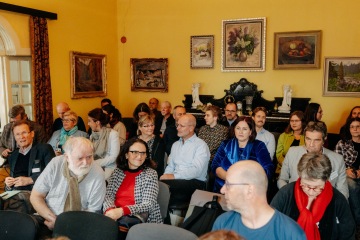
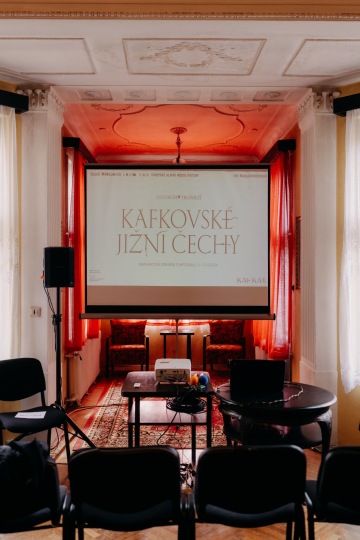

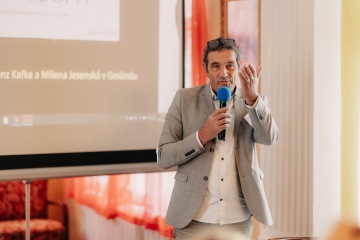
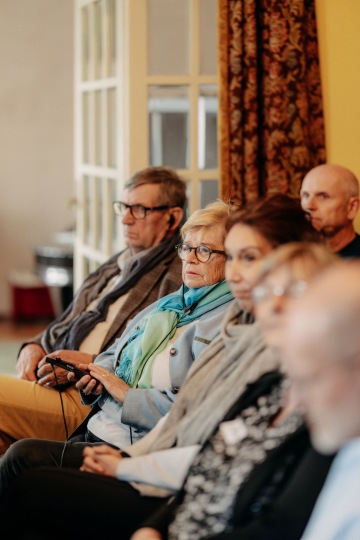

Hermann Kafka from Osek / Excursion to Osek near Strakonice, October 13, 2024
By: Mikuláš Zvánovec
The second accompanying program of Kafkaesque South Bohemia was a guided and simultaneously interpreted excursion to Osek near Strakonice, featuring commentary from writer Alena Wagnerová and former Osek chronicler Jana Vačkářová. This marked the first public excursion of its kind. The group gathered at the train station in Radomyšl to embark on a roughly 6 km long walking tour tracing the Jewish history of the village. Under the guidance of Jana Vačkářová, participants learned many details about both recent and older history of Osek, particularly its Jewish community, which included a synagogue and the birthplace of Hermann Kafka. Hermann Kafka experienced a very impoverished childhood here, but he eventually managed to open a haberdashery business in Prague's Old Town through diligence and discipline. This experience likely had a significant impact on his son's upbringing, as he sought to instill in him the same qualities he needed for social advancement.
The group then visited the previously inaccessible Osek Castle, which currently houses a home for people with disabilities. The castle, which some authors (such as Ladislav Stehlík) claim inspired Kafka’s famous novel, boasts a large castle garden where participants could discover the Chapel of St. John of Nepomuk and the forgotten tomb of General Peter Arnold. The former estate of the knightly Daubek family, in its Neo-Baroque form from 1911, also offered attendees a musical experience. Two residents of the home performed several organ pieces for the international audience in the castle chapel.
The excursion continued under Alena Wagnerová’s guidance to the hill above Osek, where the Jewish cemetery is located. The cemetery was established before 1838, with the last burial occurring in 1905. The oldest tombstones date back to the cemetery’s founding, with around fifty still remaining. Among those buried there are Kafka’s grandparents, Jakob Kafka and Františka Kafka, née Platowská. Alena Wagnerová also shared her memories of her visits to Osek while working on her book "In the Focus of Unrest," which examines Kafka's family, allowing for the capture of both the positive and negative changes in the cemetery's appearance over recent decades. Discussions also encompassed linguistic and social issues concerning the Jewish community in Osek within the context of 20th-century history.
The excursion concluded in the picturesque Radomyšl, closely associated with the activities of the Order of the Knights of Malta. Final discussions, heartfelt conversations, and planning for future meetings or events within the Borderland Center took place at a local pub.

